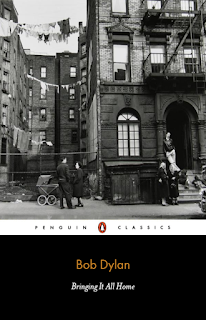Letters to Woody is a 1962 collection of Dylan's observations on the America he encountered in the first two decades of his life. Whether travelling with a carnival across the Mid-West, faking his way onto university campuses, or falling in love on the dark side of New Orleans, Dylan's sometimes rough sketches always portray the people he meets with great affection. A short, sharp introduction.
Freewheelin' (1963) is Dylan's first collection of short stories, capturing the excitement of finally finding a home and purpose in New York. Tales of young love, friendships, and the gradual awakening of youthful awareness. The magnificent "Hard Rain" is a narratively experimental precursor of great things to come.
Looking back, many say that this second collection is a little too on-the-nose with its hard-edged, almost preaching tone. But there are enough personal tales in The Times to cause us to return again and again, and "A Lonely Death" still stands as one of the finest pieces of writing to come out of a tumultuous decade.
A cause-celebre after the success of his previous volume, Dylan confounded expectations with this third collection. Collecting together slight observations on city life, sometimes overly-dramatic tales of romantic entanglements and perhaps too-indulgent takes on the nature of the writer's role in society, Other Sides is still an enjoyable read before the arrival of a now sacred trilogy.
1965 was to bring not one but two surprises. The first was Dylan's first novel. The second, not six months later, was his second. Bringing It All Home is his first masterpiece. An unnamed artist moves through the city, observing life from within his self-imposed ivory tower. A parade of characters and plots dance around him. Of course some in literary circles were offended at this young climber's claim on the novel form. Such disdain would not stop Dylan.
In which the writer sets his eyes on America again. The heart-wrenching journey of Miss Lonely is still staggering in its complexities and daring. From her formative years in a 50s prep school to her final devastating days among the desolate angels, via a lost month in San Jaurez, south of the border, this is one for the ages. Dylan has since said that the characters in Highway 61 Again were easy to come by. "All I had to do was change their names".
The Blonde (1966) is only superficially concerned with the title character. The central figure here is the Unnamed Narrator, swallowed by the society around him. Epic, dark and frivolous by turn, the plot, a seemingly simple love triangle, resolves itself over time into an examination of what it is to be human, and the roles we play. The opening pages, set at a New Orleans funeral is joyous in its raucousness; the famous long final chapter is devastating in its quiet tragedy.







Wonderful! I'll order the full set
ReplyDeleteAlready have these but as mine are now a little battered having been re-read so many times, I think I'd love some new editions.
ReplyDeleteI want a copy please! I rarely want to bother to read but this is totally up my alley.
ReplyDeleteThis comment has been removed by the author.
ReplyDeleteYo! Especially The Blonde is definitely one of the Great Novels in Twentieth Century American Literature; it's a complete mystery that this and other major works from His Master's Hand has not been included in the Penguin Classics series before now; on the other hand, it took centuries for the French Pleiades series to decide on whether to include Marquis de Sade in the canon or not, so we can't complain, only applaud this great initiative. Does anyone know if there are plans for republishing his dramatic work as well? (I am thinking especially of "The Black Coat Trilogy" from the early nineties)?
ReplyDeletehuh?
ReplyDelete